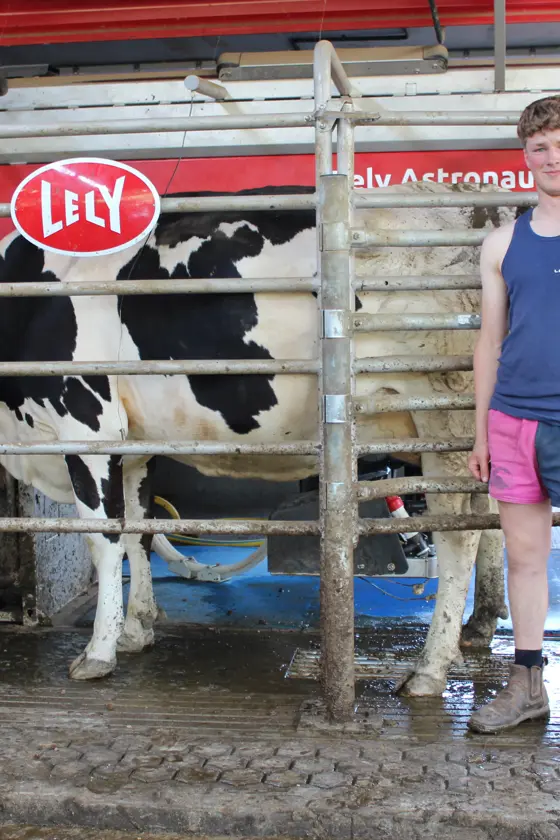Robots build flexible future for rugby mad family

Robots build flexible future for rugby mad family
Robots have proved the perfect fit for one Devon family who want to find the balance between a busy mixed farming business and a love of rugby.
The installation of two Lely A5 Astronaut milking robots means the Phillips can spread their time between contracting, finishing beef cattle and managing the 90 cow dairy herd.
“You can do a lot more with your day,” says Gary Phillips.
The family will scrape and feed up first thing in the morning, then head out contracting, returning at midday to check the cows and fork up feed. They will then be out again for the afternoon before returning to do the night check. The flexibility of the system also allows brothers, Mark, Charlie and parents, Gary and Lorraine to go out for the day to watch a game of rugby or any other activity.
Work life balance
“We like our rugby and we’re not tied to 4am to 4pm,” Gary says. “Everything is a lot more relaxed. You’re not relying on staff all the time. We toyed with a parlour to increase the herd, but staff is a big problem.”
The decision to go back into dairying came about relatively recently, spurred on by Mark and Charlie’s interest. In 2001 the family had lost their 140 cow British Friesian herd to Foot and Mouth Disease. This, together with dated facilities meant they decided to come out of milk. In the 20 years that followed, Gary set up his own contracting business doing forage work, cultivation and baling in a 20 mile radius of the farm. The beef side of the business was also expanded to a peak of 700 head of predominantly Continental cross dairy cattle.
“I’ve always liked cows, but the kids were young. It wasn’t until they were old enough to play a part (that we thought about dairying). If they weren’t keen, I wouldn’t have done it,” Gary reflects. “I like watching rugby Saturday and I like shooting. And my mum said, if you don’t get robots, you won’t have a life,” he says.
New system
To free up space and generate cash for the dairy, beef numbers were halved to 200 head. The team at Lely Center Holsworthy helped with the designs to convert an existing loose housed shed for the robots. This included installing a central feed passage with two pens, each with 58 sand cubicles and a Lely A5 Astronaut.
Gary says Lely was the first choice for robots. “The first robot you think of are Lely because they’ve got so many out there. That’s why I went with them,” he explains.
The first robot was up and running at Gosses Farm, in April 2023, with the following operational in November 2023, when cow numbers were sufficient. The herd was established with 50 bought-in, in-calf heifers and 40 fresh calved cows. None had been milked through robots before.
“The heifers take to it just like that and most of the cows do,” Gary says. “You get the odd one or two that take two weeks to get used to it. Most, after five days are walking in on their own.”
The herd calves all year round, with Gary targeting 10,000 litres a cow a year to “make it stack up” - a figure the herd is already achieving.
Although work life balance was a big attraction with automated milking, Gary says the data available through the robot is hugely beneficial. “I do like the technology in the robot. It’s so much better for the cows. It spots mastitis before the human eye can see it.”
Health monitoring
Gary says a reduction in rumination rate has proved “really good” at picking up sickness. He’ll use this as an initial red flag, which he’ll use to then look at a cow’s somatic cell counts, which are assessed daily through the robot. He’ll also look at milk conductivity and temperature which is monitored at every milking.
If conductivity and SCC are elevated, a cow will be segregated and stripped. If no visible clots are seen, she’ll be given Udder Mint. Such prompt treatment prevents issues from escalating. As a result, Gary believes antibiotic use is “bound to” be lower.
In the next five years, the aim is to erect a new shed with two more robots, plus a loose calving yard and calving box. However, labour efficiencies will always be at the forefront of decision making. “I want it so one man can do it all if needs be,” Gary says.
Farm Facts
• Gosses Farm, Chumleigh.
• Family partnership between Gary Phillips, wife Lorraine and mother Lorna. Sons Charlie, 19 and Mark, 17 work in the business.
• 344ha (850 acres) total area farmed across all enterprises.
• 90 Holstein cows.
• Two Lely A5 Astronauts.
• 3.7 robot visits per cow per day.
• 10,000 litres at 4.41% fat and 3.47% protein.
• Supplying Crediton Dairies.
• 40% of cows put to sexed semen and the rest to British Blue.
• 115,000 cells/ml somatic cell count.
• 15 bactoscan.
• D & G Phillips & Partners contracting business doing forage work (team of five).
• 200 beef cattle finished annually.
• 121ha (300 acres) of arable and 81ha (200 acres) of maize.